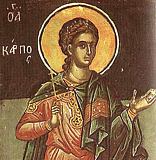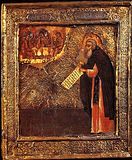

| Previous day | Next day |
| Old Style
May 26
|
Saturday |
New Style
June 8
|
| 5th Week after Pascha. Tone 4. | No fast.
|
![]() Apostles Carpus of the Seventy and Alphaeus (1st c.).
Apostles Carpus of the Seventy and Alphaeus (1st c.). ![]() New Martyr George the New, of Kratovo (Sofia) (1515).
New Martyr George the New, of Kratovo (Sofia) (1515).
Martyrs Abercius and Helen, children of Apostle Alphaeus (1st c.). St. John the Confessor, of Psycha on the Bosphorus (9th c.). Uncovering of the relics of St. Macarius, founder of Kalyazin Monastery (1521).
Tabynsk Icon of the Most Holy Theotokos.
St. Augustine, archbishop of Canterbury, evangelizer of England (ca. 605). St. Synesius, bishop of Carpasia on Cyprus (5th c.). New Martyr Alexander of Thessalonica, at Smyrna (1794). New Hieromartyrs Milan Banjac and Milan Golubovic, of Drvar, Serbia (1941-1945).
Repose of Archimandrite George (Kapsanis) of Gregoriou (2014).
Thoughts for Each Day of the Year
According to the Daily Church Readings from the Word of God
By St. Theophan the Recluse

Saturday. [Acts 15:35–41; John 10:27–38]
Though ye believe not Me, believe the works, says the Lord (John 10:38). The works of the Lord were obvious to all, and He could point to them openly. They are: the healing of various diseases, the driving out of demons, power over nature, knowledge of thoughts of the heart, the prophesying of the future, power of the word, and dominion over souls. All of these clearly proved that Jesus Christ was from God, and that His word was the truth. For us other works were added to these—a marvellous death, resurrection, ascension, descent of the Holy Spirit, foundation of the Church, marvellous spiritual gifts in believers, triumph over pagans and grace-filled power which to this day has not ceased to act in the Church of God. All of these are the works of the Lord. To any unbeliever one can say: if you do not believe the word, believe these works, which loudly witness to the Godhood of our Lord Jesus Christ; and having come to belief, accept His entire truth. But how did those Jews answer the Lord at that time? They sought again to take him (John 10:39). What do today’s unbelievers do? They sit and weave lie onto lie, in order to “take” not the Lord—for this is not according to their strength—but to take those who are simple in faith and cannot unravel their sly weavings.
Articles
 Apostle Carpus of the SeventyHe was bishop of Verria in Macedonia. |
 Greatmartyr George the New at Sofia, BulgariaThe Holy Martyr George the New was born into an illustrious Bulgarian family, living in the capital city of Bulgaria, Sredets (now the city of Sofia). |
 Martyrs Abercius and Helen, children of the Apostle AlphæusAccording to Tradition, the Holy Martyrs Abercius and Helen were children of the holy Apostle Alphaeus. |
 Venenerable Confessor John Psykhaϊtēs |





